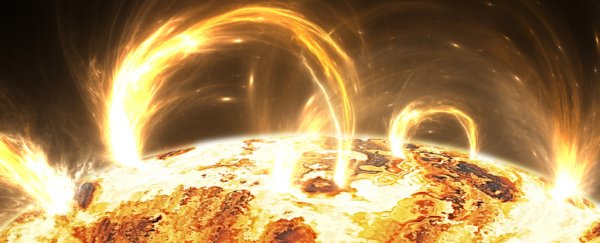After over a century of observations and several theories, scientists may have finally nailed the origin of the high-speed plasma blasting through the Sun's atmosphere several times a day. Using a state-of-the-art computer simulation, researchers have developed a detailed model of these plasma jets, called spicules.
The new findings answer some of the bigger questions in solar physics, including how these plasma jets form and why the Sun's outer atmosphere is far hotter than the surface.
"This is the first model that has been able to reproduce all the features observed in spicules," Juan Martinez-Sykora, lead author and astrophysicist at the Bay Area Environmental Research Institute in California, told ScienceAlert.
Every five minutes, spicules shoot red hot streams of charged particles into the corona, the outer layer of the solar atmosphere, at around 150 kilometres (93 miles) per second (paper). Lasting up to 15 minutes it is estimated that up to 300,000 spicules are active at any one time.
The bizarre thing about the corona is that it's totally counterintuitive when it comes to temperature.
Even though it's further away, it's millions of degrees hotter than the Sun's surface, thanks to the constant supply of hot plasma delivered by the spicules. This jump in temperature is kind of like standing some distance away from a bonfire and feeling hotter than the fire itself.
While scientists have been aware of spicules for over a century, their origin has remained a puzzle. Over the years, there have been several theories that have attempted to crack the mystery.
One study suggested that spicules are generated by massive sound waves, while a more recent study proposed that their formation is due to the magnetic field forming loops out of the atmosphere.
But these theories only provided fragments of the story which failed to explain the origin of spicules and why they are found all over the sun.
Speaking with ScienceAlert, Lockheed and Martin Solar and Astrophysics Laboratory principal physicist Bart de Pontieu said observing the spicules from the ground has its limitations.
"It's been very hard to get a clear view of what these spicules do, as Earth's atmosphere creates a murky picture," said de Pontieu, who was also a co-author on the paper. "But thanks to space telescopes, we can now see what they really look like in greater detail."
And now, Martinez-Sykoro and his team have developed a computer model that can generate simulations of these powerful plasma jets in action, allowing the researchers to track different temperatures and physical features.
The numerical model revealed that the formation of spicules happens in three distinct stages.
The process begins on the surface of the Sun where churning plasma interacts with the magnetic fields, which get twisted up and knotted in the process. This distortion creates strong magnetic tension trapped close to the surface.
Next, neutral and charged particles mix above the surface in a process called ambipolar diffusion, which creates an escape route for the building magnetic tension. Then, like a slingshot, the magnetic tension is violently released into the atmosphere and out into space at staggering speed.
"These jets of plasma are ejected so fast that they could traverse the length of California in just a couple of minutes," De Pontieu told ScienceAlert. "They can reach heights of 10,000 kilometres, roughly the diameter of Earth, in just five to ten minutes."
To see how the simulations stacked up against the real thing, the team analysed data from NASA's Interface Region Imaging Spectrograph and the Swedish Solar Telescope. They found that the simulations recreated the properties of actual spicules, including the size, speed and shape.
In addition to solving the long-held mystery of how spicules form, the new findings demonstrate how the plasma jets blast millions of degrees of heat into the scorching corona.
"It's exciting because it explains why the solar atmosphere is millions of degrees hotter than the surface," De Pontieu told ScienceAlert.
Now that scientists know how spicules form, they can take a closer look at how they interact with the outer reaches of the solar atmosphere.
The study has been published in Science.
